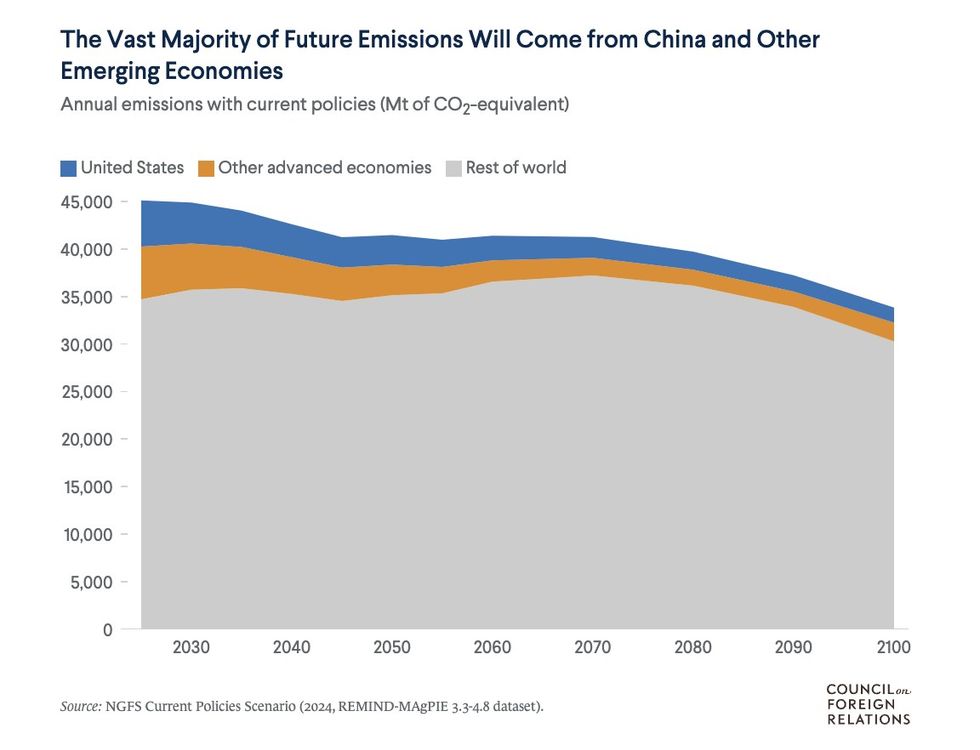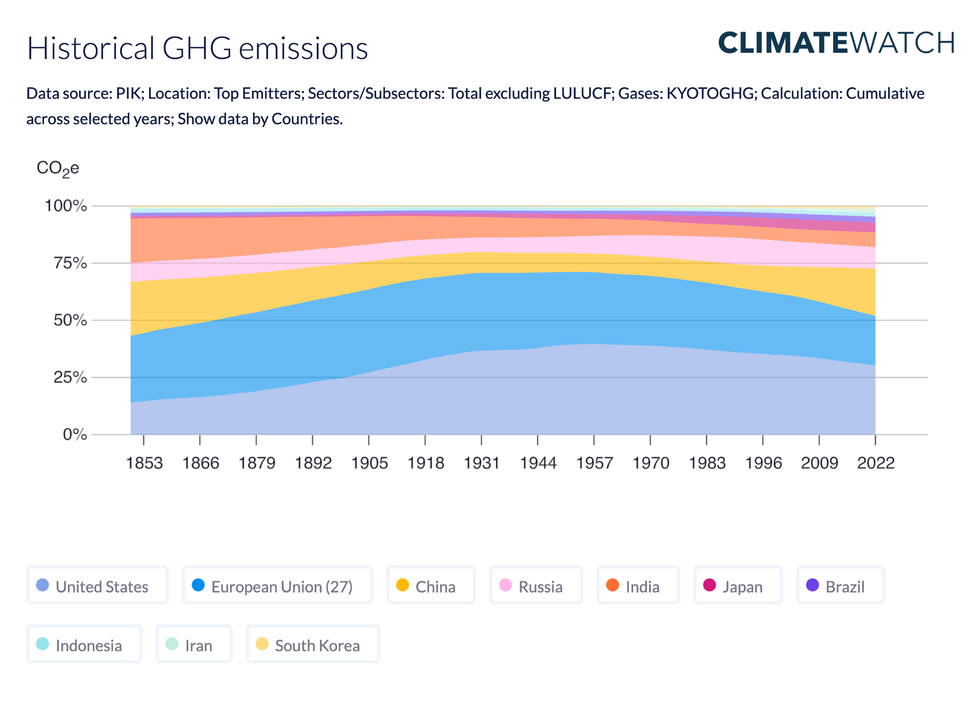On the heels of a new United Nations report finding that over 150 “unprecedented” floods, heatwaves, hurricanes, and other climate disasters struck in 2024, the Council on Foreign Relations has launched its new “Climate Realism Initiative.” The Initiative’s goals proffer a dangerous and ahistorical set of climate politics, washing the United States’ hands of any responsibility to clean up global emissions or cooperate internationally to prevent the catastrophic impacts of 3°C of warming.
In a recent article branding the Initiative, CFR fellow Varun Sivaram shamelessly lays out the three main pillars of so-called “climate realism”: (1) that the world will overshoot the Paris agreement’s target to limit warming to 1.5 and even 2°C, (2) that the U.S. should eschew its own emissions reductions in favor of investing domestically in new clean technologies that can compete globally, and (3) that the U.S. should lead international efforts to avert catastrophic climate change.
In light of the first and second, the hypocrisy of CFR’s third pillar is particularly absurd.
CFR’s agenda is as tone-deaf as it is without bearing in history, science, or morality.
On the first pillar, Sivaram argues we should simply accept and prepare for a world with 3°C of warming—his so-called “realism”—but doesn’t stop to share what such a “real” world would look like.
At 3°C, 3.25 billion people will be exposed to lethal heat and humidity every year. The number of people globally who lack sufficient access to water will double. The majority of coral reefs will die. Sea levels will rise, threatening low-lying islands like the Marshall Islands in the Pacific and coastal cities like Bangkok, Shanghai, Amsterdam, and New Orleans. Agricultural yields will tumble, with most crops across the world suffering.
Perhaps most terrifying, the risk of hitting irreversible and catastrophic climate tipping points—like the wholesale dying off of the Amazon or melting of the Arctic—significantly increases.
Stepping back for a moment, it’s important to remember that the Paris agreement’s 1.5°C target came to be because frontline countries demanded such a target. With the Global North coalescing around 2°C ahead of COP21 in Paris and anything more ambitious thus thought politically infeasible, small island countries stunned many observers in leading more than 100 countries in demanding “1.5°C to stay alive.” Such a target, many, like the Marshall Islands’ Tina Stege, argue is necessary to avoid inundating and erasing island nations and low-lying places across the world.
Yet, rich countries in the Global North—and notably the U.S.—have too often ignored these calls in favor of a target that enables the continued extraction and burning of fossil fuels, prioritizes profits today over catastrophe tomorrow, and maintains the enormous wealth gap between Global North and South. By arguing that the U.S. should cast off the world’s 1.5°C and even 2°C target, Sivaram simultaneously condemns the Global South to a future with catastrophic and irreversible warming, a world without islands, where the Marshall Islands as we know them simply cease to exist.
It is within this context, then, that Sivaram advances the Initiative’s second pillar by presenting the following chart. With it, he argues that reducing U.S. emissions won’t make a meaningful difference because they’re a small share of projected future total global emissions.

However, in so doing, Sivaram ignores—even obfuscates—historical emissions. Consider a different chart, this one from Climate Watch, which illustrates the U.S.’ and the broader Global North’s role in creating the climate crisis in the first place. Looking back to the late 1800s, the U.S. and the European Union are responsible for over 50% of historical global greenhouse emissions (in CO2e).

In contrast, Small Island Developing States (SIDS)—a group of 39 island nations, including the Marshall Islands, across the Caribbean, Pacific, Atlantic, Indian Ocean, and South China Sea—have collectively contributed less than 1% of global emissions. Yet, SIDS and their nearly 65 million inhabitants are on the frontlines of the climate crisis, threatened by intensifying hurricanes and cyclones, shrinking biodiversity, and rising seas that threaten to swallow them whole.
Thus, Sivaram’s imperial assertion that U.S. emissions aren’t relevant to a “climate realism” agenda ignores what climate justice advocates have been raising for decades: that those most responsible for climate change should, in turn, be most responsible for addressing it. Instead, Sivaram offers an ahistorical perspective on emissions in service of uncapped emissions and U.S. exemption from climate accountability.
And then, finally, Sivaram offers his astoundingly contradictory final pillar: that the U.S. should lead efforts to avert catastrophic climate change. With the U.S. already a historic laggard and obstructionist in global climate negotiations, it’s hard to imagine a world in which the U.S. could possibly be seen to lead on climate while ignoring its own emissions reductions and sacrificing broad swaths of the Global South to sea-level rise, deadly heatwaves, and cascading crises driven by climate.
CFR’s agenda is as tone-deaf as it is without bearing in history, science, or morality. This dangerous initiative is anything but realistic, instead smuggling in a blatantly imperial and morally bankrupt agenda in a grotesque attempt to curry favor with a nationalist and climate-denying American right.
The climate movement must swiftly denounce this agenda and work toward one that aims to avoid overshoot at all costs, repair historic injustice, and uphold the value and dignity of human life across the globe.





